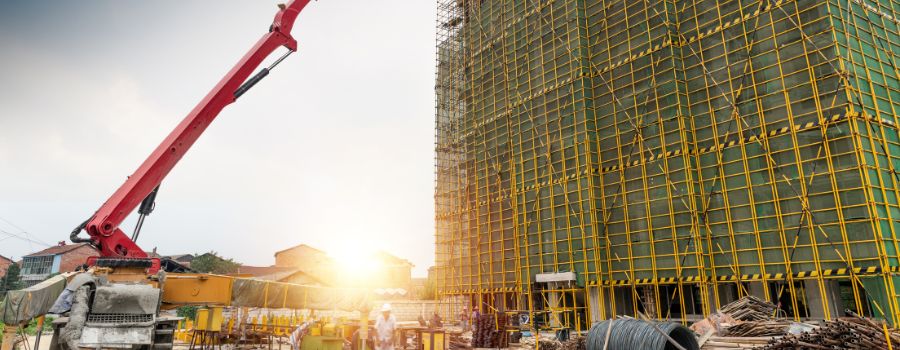6 Advantages of Using Boom Pumps for Concrete Deposition
In the ever-evolving world of construction, efficiency and precision are paramount. When it comes to concrete deposition, boom pumps have emerged as a game-changer, offering numerous advantages over traditional methods. Whether you're working on a towering skyscraper or a sprawling foundation, understanding these benefits can help you make informed decisions for your next project. So, let's delve into the six key advantages of utilizing boom pumps for concrete deposition:
1. Unmatched Reach and Accessibility:
Boom pumps reign supreme when it comes to conquering challenging placement scenarios. Their articulated arms boast impressive horizontal and vertical reach, effortlessly navigating obstacles, reaching remote locations, and eliminating the need for scaffolding or manual carrying. This translates to concrete placement in:
- Elevated structures: Bridges, high-rise buildings, and retaining walls become easily accessible, reducing reliance on cranes and enhancing safety.
- Deep excavations: Foundations, basements, and underground structures, often inaccessible to traditional methods, become readily reachable with a boom pump's flexible arm.
- Tight spaces: Confined areas between buildings, culverts, and congested urban environments are no match for the maneuverability of a boom pump.
2. Enhanced Speed and Efficiency:
Time is money in construction, and boom pumps deliver significant time-saving benefits. Their continuous pumping capability eliminates the need for manual labor and bucket-by-bucket pouring, leading to:
- Faster placement: The steady flow of concrete accelerates the pouring process, often completing it in a fraction of the time compared to manual methods.
- Reduced downtime: Minimized reliance on labor and equipment setup translates to fewer interruptions and smoother, more efficient operations.
- Increased productivity: Faster placements enable crews to move on to other tasks sooner, boosting overall project productivity.
3. Improved Accuracy and Control:
Precision is crucial for ensuring structural integrity and minimizing waste. Boom pumps offer superior control over concrete placement compared to gravity-driven methods:
- Precise positioning: The operator can manipulate the boom with utmost accuracy, delivering concrete exactly where it's needed, even in intricate forms and complex structures.
- Reduced segregation: Continuous pumping minimizes the risk of concrete segregation, which can compromise strength and uniformity.
- Minimized waste: Accurate placement and reduced splatter lead to less wasted concrete, translating to cost savings and environmental benefits.
4. Enhanced Safety on the Job Site:
Construction inherently involves risks, but boom pumps can contribute to a safer work environment:
- Minimized manual handling: Eliminating the need for workers to carry heavy buckets or maneuver through challenging terrain reduces the risk of injuries.
- Reduced exposure to hazards: Workers stay farther away from moving concrete trucks and pumps, minimizing exposure to potential spills or splashes.
- Improved access to fall protection: Boom pumps can provide platforms for workers to access difficult areas while utilizing fall protection equipment.
5. Cost-Effectiveness in the Long Run:
While the initial cost of renting or purchasing a boom pump might seem higher, the long-term benefits often outweigh the investment:
- Reduced labor costs: Less reliance on manual labor translates to significant cost savings, especially on large projects with extensive concrete requirements.
- Faster project completion: Reduced downtime and increased efficiency lead to faster project completion, potentially saving on site management and overhead costs.
- Minimized waste: Precise placement and less splatter lead to reduced concrete waste, translating to material cost savings.
6. Adaptability and Versatility:
Boom pumps are not one-size-fits-all solutions, but they boast remarkable adaptability to various project needs:
- Multiple configurations: Different boom sizes and reach capabilities cater to diverse project demands, from small residential builds to massive infrastructure projects.
- Pumping capacity variations: Flow rates can be adjusted to match specific concrete types and placement requirements.
- Attachment options: Boom pumps can be equipped with specialized attachments like placing hoses, funnels, and distribution lines for even greater versatility.
Beyond the advantages listed above, consider these additional factors when making your decision:
- Project size and complexity: Larger and more intricate projects often benefit significantly from the reach, accuracy, and efficiency of boom pumps.
- Site access and constraints: Boom pumps excel in navigating tight spaces and reaching challenging locations, offering solutions where traditional methods fall short.
- Budget and cost considerations: While the initial investment might be higher, consider the long-term cost savings from reduced labor, faster completion, and minimized waste.
Conclusion
Boom pumps are a powerful tool in the construction industry, offering a multitude of advantages for concrete deposition. From superior reach and efficiency to enhanced safety and cost-effectiveness, they cater to diverse project needs and contribute to a smoother, more productive construction experience. By carefully considering your project requirements and evaluating the benefits, you can determine if a boom pump is the best choice for you.
For more details on boom pumps, connect with the team!
